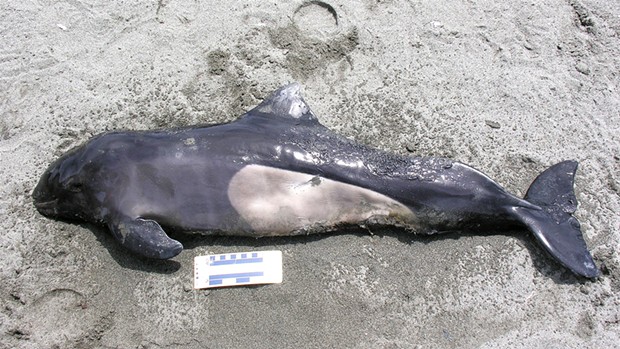[
{
"name": "Top Stories Video Pair",
"insertPoint": "7",
"component": "17087298",
"parentWrapperClass": "fdn-ads-inline-content-block",
"requiredCountToDisplay": "1"
}
]
My Michael beat up a motorcycle gang unnecessarily. So, I grounded him, and I'm writing his Washed Up column this month. It's a story about a loving mommy and the precious baby she lost.
Early one summer, we found a baby Dall's porpoise (Phocoenoides dalli) washed up dead on the beach. Because my Michael is a tactical genius, he sized things up accurately. He could tell this was a baby because its size was consistent with a newborn at about 3 feet long. And it even had cute whiskers on its snout! It was so fresh that its mommy might have still been grieving. I wept, but My Michael is a hardened man, so he didn't.
Another man approached and said, "Cool, a baby killer whale." This man was almost as intense and muscular as my Michael, but he clearly wasn't the sharpest harpoon in the fleet.
My Michael said, "Actually, this is a baby Dall's porpoise. A killer whale is black with white eyepatches and a white saddle. A Dall's porpoise is mostly black and only has a white belly patch and some white on its fins. Plus, a newborn killer whale would be about 15 times heavier."
The man struck an aggressive pose and had the temerity to argue. Unfortunately for him, my Michael invented a martial art called Mike-Fu. Devoted practitioners of Mike-Fu focus their energy upon a single target: their opponent's nuts. We left the man writhing next to the dead baby.
The poor Dall's porpoise mommy would have carried her baby for 10 to 12 months. Oh god, it's so sad ... OK, sorry. The mommy would have become sexually mature at between about 4 and 8 years of age. And if not for this horrible tragedy, her baby may have lived another 20 years and grown to more than 7 feet long and 400 pounds.
Adults have a relatively small head on a stout body. But for being such chunky-looking animals, they are surprisingly fast. Various estimates rank either Dall's porpoise or the killer whale as the fastest marine mammal, with top estimates of 34 miles per hour in short bursts. And Dall's porpoises' triangular dorsal fins throw a characteristic "rooster tail" when swimming fast at the surface, like when riding a boat's bow wave.
They range around the North Pacific rim from southern California to southern Japan. Scientists estimate that there are about 800,000 Dall's porpoises rangewide, with around 100,000 off California, Oregon and Washington.
While most other porpoises live in shallow water, Dall's porpoise is a deepwater species. They are seldom seen in areas where the smaller harbor porpoise species is common, like in our local nearshore and bay waters. However, scientists have found hybrids of Dall's and harbor porpoises, so their populations do overlap — at least during times of friskiness.
Dall's porpoises can dive to more than 1,600 feet while hunting fish, squid, octopus and swimming crustaceans. They use echolocation to find prey and have many small paddle-shaped teeth, which are well-suited to grabbing their slippery quarry, just like if my Michael were to grab someone by their greasy throat.
Dall's porpoises occasionally swim with fish-eating populations of killer whales. This behavior appears to include mutual play with baby killer whales. But the porpoises are also preyed upon by mammal-eating populations of killer whales, so Dall's porpoise can apparently see or hear the difference between killer whale ecotypes from a safe distance.
In closing, I am strong — uh — I mean, my Michael is strong and violent, and he doesn't know anything about the naughty selfies on your wife's phone.
Signed,
Michael's Mother.
Biologist Mike Kelly (he/him) is also the author of the book Tigerfish: Traditional and Sport Fishing on the Niger River, Mali, West Africa. It's available at Amazon, or everywhere e-books are sold.
more from the author
-
Washed Up Love
- Jul 18, 2024
-
The Parchment Worm Turns
- May 30, 2024
-
Hot Tomcod Action
- Apr 18, 2024
- More »
































